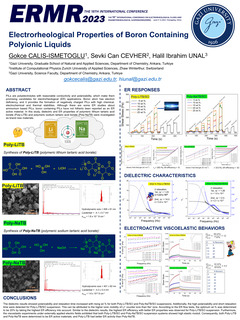Electrorheological Properties of Boron Containing Polyionic Liquids
ID:25
Submission ID:44 View Protection:ATTENDEE
Updated Time:2023-03-14 09:21:19 Hits:828
Poster Presentation
Abstract
Poly(ionic liquids) (PILs) are becoming popular in material science and engineering in recent years due to their tunable solubility, ionic conductivity, electrochemical stability, thermal stability and nonflammability depending on the type of cation-anion pairs. PILs are polyelectrolytes with reasonable conductivity and polarizability, which make them promising candidates for electrorheological (ER) applications. Boron atom has electron deficiency, and it provides the formation of negatively charges PILs with high chemical, electrochemical and thermal stabilities. Although there are some ER studies about ammonium based PILs, boron containing PILs have not been reported as an ER active material yet. In this study, dielectric, and ER properties of polymeric lithium tartaric acid borate (Poly-LiTB) and polymeric sodium tartaric acid borate (Poly-NaTB) were investigated as brand new material. Firstly, the polymers were suspended in silicone oil (SO) with 5-25 wt.% with 5% increments. The dielectric results showed that the dielectric properties, polarizability, and relaxation time, increase with rising wt.% for both Poly-LiTB/SO and Poly-NaTB/SO suspensions. Additionally, the high polarizability and short relaxation time were obtained for Poly-LiTB/SO suspension. This can be attributed to the higher mobility of smaller Li+ counter ions than Na+ ions. According to the ER flow tests, the optimum wt.% was determined to be 20% considering the highest ER efficiency. Similar to the dielectric results, the highest ER efficiency with better ER properties was observed for Poly-LiTB/SO suspension. Furthermore, the viscoelastic experiments under externally applied electric fields exhibited that both Poly-LiTB/SO and Poly-NaTB/SO suspension systems showed high elastic moduli. Consequently, both Poly-LiTB and Poly-NaTB were determined as ER active materials, and Poly-LiTB had better ER activity than Poly-NaTB.
Keywords
electrorheology,dielectric,poly(ionic liquids),boron
Submission Author
Gokce Calis-Ismetoglu
Gazi University
Sevki Can CEVHER
Zurich University
Halil Ibrahim UNAL
Gazi University


Comment submit